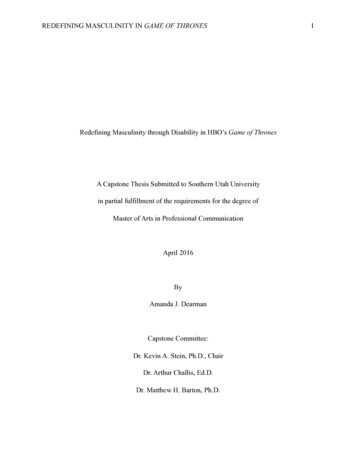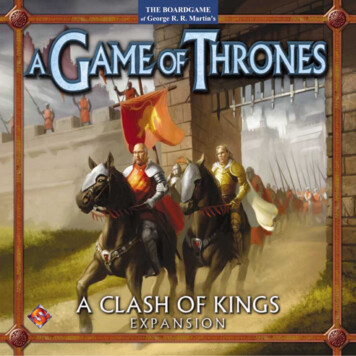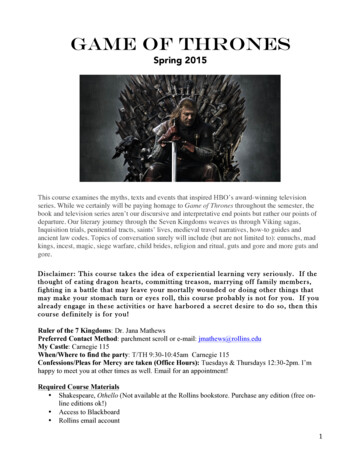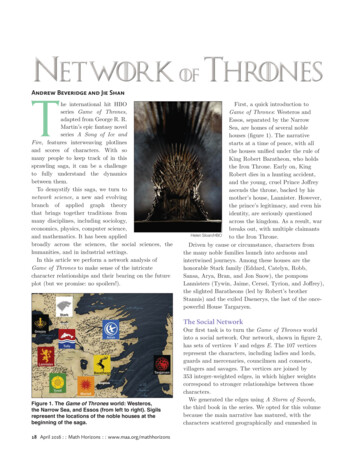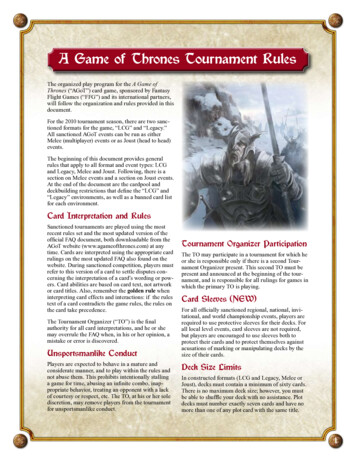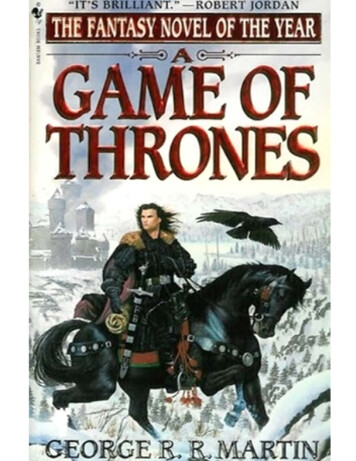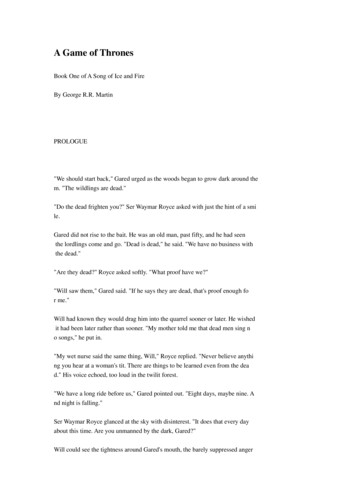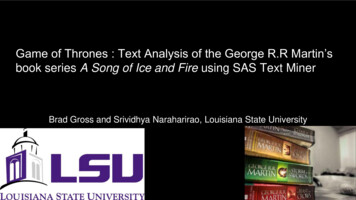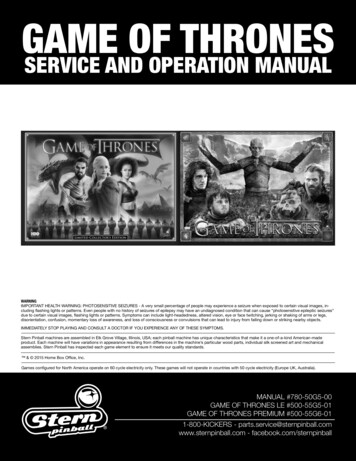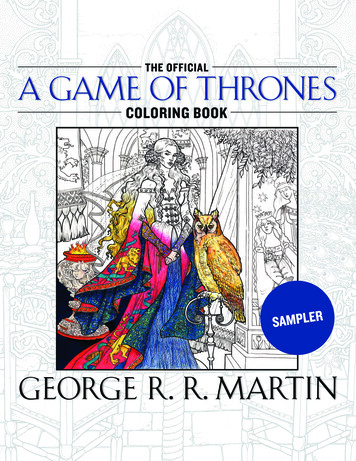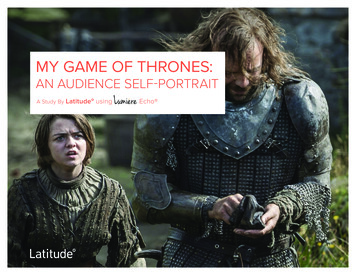
Transcription
MY GAME OF THRONES:AN AUDIENCE SELF-PORTRAITA Study ByLatitudeº usingEcho
WE ASKED 220 GAME OF THRONES FANS ACROSS THEUNITED STATES TO TELL US WHAT IT REALLY MEANS TO BEA FAN, AND WHAT KEEPS THEM COMING BACK FOR MORE.21FANS RECORD THEMSELVESANSWERING QUESTIONSWE COMPILE A MINI-DOCUMENTARYACCOUNTING FOR A VARIETY OF RESPONSES3OTHER FANS WATCH VIDEO AND INDICATE THEIRAGREEMENT WITH OPINIONS EXPRESSED“My favorite characterthat I relate to the mostis Sansa Stark. I thinkshe’s a little dark, a littlemysterious.”TAGS INDICATE AGREEMENT(MOUSE CLICKS)Game of Thrones has, almost unexpectedly, become a worldwide hit over the past few years.What’s driving the intense loyalty and social interactions of fans? How do people who love the program connect to the unique world of GoT and tothe multi-faceted characters in it?As part of our ongoing series of open studies onmedia and technology, we decided to explorethese questions, with the ultimate goal of gaininga deeper understanding of how compelling serieslike GoT can reach, and retain, loyal audiences.Latitude asked 220 Game of Thrones fans to helpus understand what truly makes the show sucha huge hit. First, we asked 20 people to tell usMY GAME OF THRONES:AN AUDIENCE SELF-PORTRAITabout their routines and rituals around the HBOshow – all through self-recorded video. Next, wecompiled their responses into a mini-documentary and presented it to a larger audience of fans(n 200) via our cloud application, Lumière. Asthey watched the collage of input, these fans interactively provided their own feedback regardingthe ideas expressed.What follows is a story of Game of Thrones fansand the characters they enjoy on-screen. This colorful portrait of fandom showcases the connections between people off-screen that can be facilitated by people on-screen, and can be appliedto audiences across genres and around the world.LOCATION OF STUDY:38º / 53’ : UNITED STATESTIME OF STUDY:JULY 2014METHOD OF STUDY:ECHO (COLLABORATIVE VIDEO ETHNOGRAPHY)2
DIVING UNDER THE CROWN - VIEWER PSYCHOLOGYWhy do you watch Game of Thrones?level of agreement (#of clicks)1SCI-FI /WITCHCRAFT /MAGIC2THE VILLIANS OFTEN WIN,NOT ALWAYS A HAPPY 040302010030 sec12MEDIEVAL, FANTASY WORLD REIGNS OVER ME The world ofGame of Thrones provides a rich backdrop that grounds whatare ultimately very realistic characters. The majority (54%) offans agreed that their top reason for watching is the show’s setting: a medieval fantasy with elements of sci-fi, witchcraft, andmagic. The combination of the epic and the intimate, real andunreal, in this world allows the audience to bathe realistic characters in larger-than-life scenarios.SURPRISE MAKES VIEWER HEARTS GROW FONDER Unpredictability is almost always a plus in television, but not alwaystruly present; GoT has it in spades. The result: a sense of livingwith and like the characters in the often harsh world of Westeros, never knowing what’s really around the bend. While fanswho read the book series and watch the show “intensely” knowsome of the story paths, the majority of viewers have becomeinvested in the fears and hopes of the characters in this unpredictable narrative space.time of video341 minLOATHING ALL LANNISTERS.EXCEPT TYRION Fans that aremore “intense” about their viewing are also more nuanced intheir reasons for watching. While the average viewer is moreconcerned with unpredictability and the latest killings, thesemore loyal fans sink their teeth deep into character ambiguityand complexity. Tyrion Lannister has become a focal point within this trend - even if he’s not their “favorite,” he exemplifies thestrong and complex middle ground that lies between protagonist and antagonist.CHARACTERS THAT TWIST AND TURN, AND GROW Almostevery character that appears in GoT immediately feels three-dimensional. But their ultimate appeal is linked to the unpredictability of the storylines - the characters do the truly unexpectedin many situations. What’s even more powerful is that they’recapable of real movement and change; nearly half (44%) of respondents agreed that this quality was the main reason to pickfavorites and in turn this character loyalty only creates deeperaudience loyalty over time.3
GETTING INTO CHARACTERlevel of agreement (#of clicks)If I had to describe a Game of Thrones fan, I would say they probably.LIKE MEDIEVALSCENARIOSVALUE INTRIGUE,GUILE & DECEPTIONLIKE PUZZLESARE LOOKING FOR ESCAPEFROM DAILY ROUTINE1ARE MORE INTELLIGENTTHAN TWILIGHT OR LORDOF THE RINGS FANS2COULD BEANYONE8070605040302010030 sec12DEEP CONNECTIONS WITH CHARACTERS FORGEMEANINGFUL CONNECTIONS BETWEEN FANStime of video1 minFANS ARE AS COMPLEX AND WELL-ROUNDED AS THE CHARACTERS Amongst all audience descriptors, the one that rang true for most was “more intelligent than Twilight fans, oreven Lord of the Rings fans.” GoT fans are proud of their IQ, but much like characters on theshow, their qualities are far from one-note. They’re also imaginative, adventurous, and value intrigue and deception as much as the next Lannister. Game of Thrones has created an elegantand narratively-rich match of viewer and character that, in the end, allows individuals to relateto the show and to each other in deeper ways than is the case with series that have more superficial character development.GAME OF THRONES IS MAINSTREAM.BUT DO FANS THINK SO? Game of Thrones hasan average of over 18 million viewers per episode (by comparison, the Sochi Olympics earlierthis year had just over 20 million per night). But despite GoT’s widespread popularity, less thana third of people thought that fans “could be anyone really.” Those who read the series wereeven less likely to agree that the show is mainstream, and the regularity / intensity of viewingdid not affect this statistic. Viewers shy away from calling the show mainstream because of theintimate relationships they are able to form with the show’s characters, and thus, with each other. With such a large viewership, GoT fans still act, move, and socialize like a much more nicheaudience.4
FOUR CLANS OF VIEWERSJust as the show’s characters are diverse in their habits and traditions, from House Lannister and House Tyrellto Houses Stark and Targaryen, the Game of Thrones audience cannot be personified by a lone image - forinstance, the diehard medieval fanatic who has worn out copies of the book series. In deference to that fact, wedecided to look at the audience through multiple lenses. The following are some of the more prominent groupsthat emerged, differing in their engagement and socialization around the series.WHO THEY AREthose who watchintensely and readthe book series65 35PERCENTAGE OFTOTALBEHAVIORS &SOCIALthose who watchregularly and don’tread the book series35%those who typicallywatch the showalonethose who typicallywatch the show withothers50 5050% 50%65%50%watch GoT live64%watch at home79%32%like talking aboutplot / lastepisode’s events47%61%38%like talking aboutwho got killedlike imagining fromcharacters’ POV 0%63%21%like talking aboutwho should getkilled56%48%52%like discussing thefuture of the plotlike imagining fromcharacters’ POV67%20%13%5
INSIGHTS FOR GoTMAESTERS OF MANY HOUSES. Game of Thrones fans always seemto have an opinion, even regarding experiences that are not their own.For instance, live viewers enjoy explaining the mindset and behaviorsof delayed viewers, and vice-versa. This audience characteristic is anindicator of its size and its propensity for social interaction; as peoplediscuss the show with friends and family, they solidify information aboutexperiences around the show that might be contrary to their own.TRIAL BY (SOCIAL) COMBAT. Game of Thrones has an abundance ofcomplex characters, many of whom have found their faithful fans. Evenamong the twenty people who recorded footage for us, seven differentfavorite characters were offered, a sign that there is someone in theshow for everyone who watches. There is a powerful social opportunityhere, to have these factions interact and debate with each other, allywith others against each other, etc. The initiative would provide fanswith some healthy competitive spirit and provide HBO with some potentially significant insight on social behavior around the show.FLIGHT OF THE THREE-EYED RAVENS. As it turns out, reading thebooks may remove the surprise, but not the enjoyment of the show.While non-readers insist that they enjoy the TV show more, those whohave read the books can claim both a richer understanding of characterrelationships and can enjoy seeing non-readers’ reactions to unpredictable moments while watching or discussing together. Readers of theGame of Thrones series “see deeper,” shifting their impetus to watchaway from plot development and more toward immersive experiencesand a realization of their in-depth knowledge.INVESTED IN WESTEROS. Especially for those who like to immersethemselves in the environment of Game of Thrones and personify itscharacters, a seasonal schedule or weekly episode should only be partof the journey. Providing content in the digital world, but also more content in the real world, allows these fans to play and explore. Incidentally,it not only makes live show viewing more of an inevitability, but also afurther esteemed, highly anticipated event.6
OPPORTUNITIES FOR ALLSTORYTELLERSNICHES ARE THE NEW MAINSTREAM. Don’t be wary ofsci-fi / medieval scenarios or other subjects typically reserved for niche followings. With an ever-growing array ofnetworks and viewing options, programmers and producers realize that dedicated smaller audiences can be positively evangelistic in their level of engagement - and evenlay the groundwork for potentially bigger hits.RECOGNIZE THE POSSIBILITIES OF CASTING A WIDERNET. The success of Game of Thrones can be attributedto its numerous storylines and multidimensional characters,all placed within a specific, unique universe. Creating realvariety and abundance of people and plotlines in the sameseries attracts diverse audiences that can latch onto different elements to fuel their fandom.ENCOURAGE CONVERSATION (BUT DON’T TRY TOCONTROL IT). Social interaction is a boon for a TV program. Execs will often, though not always successfully, tryand guide the conversation through a few desired channels. Do more to encourage social behavior around a showwherever and however it may exist – in social media andblogs, at real-world events, through artistic pursuits, etc.In the end, a diversity of communication channels will enhance adoption and commitment to the show.BRANDS CAN STAY IN CHARACTER. As casts of characters become more varied and plots get more complex,every brand should be able to find at least one thread thatresonates with its identity without needing to resort to appeasement. Finding this point of resonance will yield a genuine connection with fans of the show who appreciate thatsame thread, and will help avoid the risks of pandering orcompromise.7
LUMIÈRE ECHO: A NEW APPROACH TO ETHNOGRAPHYEcho is an entirely new approach to ethnographic research, providing both the deep insights you’dexpect from traditional ethnography and the scale more common to online methods. Using videomaterials as stimuli – paired with qualitative and quantitative feedback mechanisms built into thevideo screenings – Echo provides a platform for participants to share their own experiences, preferences, values, problems, and desires in real time as they watch.“I think one characterthat I think is particularlycool is the character ofthe Hound.”fewer tags meanslower agreement(fewer clicks fromparticipants)more tags meanshigher agreement(more clicks fromparticipants)“Tyrion Lannister is the bestcharacter in all of fiction at themoment. He’s so complex.”MY GAME OF THRONES:AN AUDIENCE SELF-PORTRAIT8
MY GAME OF THRONES: AN AUDIENCE SELF-PORTRAITLatitude helps clients create inspiring content and technology throughforward-looking, original research and visually rich insights.We help companies better understand and engage their audiences across thefollowing areas: Original content & programming strategy Digital & mobile product development and user experience design Advertising, branding & sponsorship opportunities and strategy Innovation at the intersection of media and technologyLumière is a cloud application designed to gather rich feedback on video content of all kinds through interactive screenings, and to analyze thatfeedback simply and powerfully through dynamic data visualizations.Study TeamNeil Basu, Senior Analyst & Study LeadAndy Wiltshire, Senior Analyst & Lead StrategistKadley Gosselin, Content Manager & Lead DesignerSteve Mushkin, President & Editorial OversightTo learn more about working with Latitude, contact:Steve Mushkin / CEO/Founder / smushkin@latd.comFor press inquiries, contact:Kadley Gosselin / Content/Communications Manager / kgosselin@latd.comCurious? Keep in touch with usLumière’s Product SuiteInterested in keeping up with the other cool stuff we’re working on?Get to know us better by subscribing to our newsletter: http://latd.com/clients-us/#maillistWe’ve built a suite of “off-the-shelf” offerings powered by Lumière. Eachof our products harnesses the power of video, with the scale andefficiency of the Web, to provide quicker results and richer data.In addition to Echo, we also offer:Connect with us here:Sequence - our approach to evaluating long-form video searchSpotlight - a multi-faceted approach to testing persuasive content.MY GAME OF THRONES:AN AUDIENCE SELF-PORTRAITPanorama - Web and application interface evaluation through videotours.VISIT US AT WWW.LATD.COMTHIS REPORT IS LICENSED UNDER CREATIVE COMMONSATTRIBUTION-NONCOMMERCIAL-SHAREALIKE
Game of Thrones provides a rich backdrop that grounds what are ultimately very realistic characters. The majority (54%) of fans agreed that their top reason for watching is the show’s set - ting: a medieval fantasy with elements of sci-fi, witchcraft, and magi
